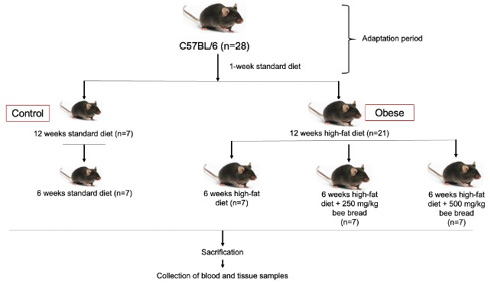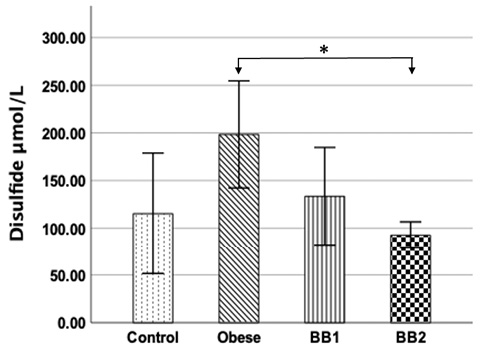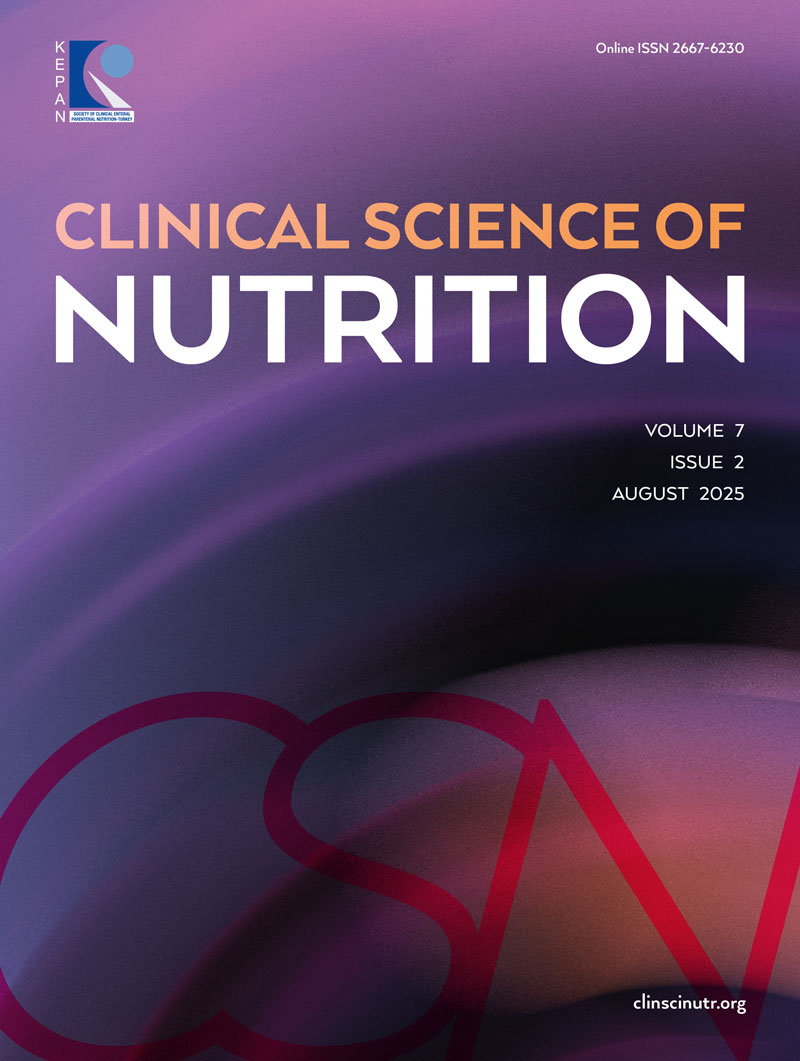Abstract
Objective: This study aimed to evaluate the effects of bee bread (BB) supplementation on thiol/disulfide homeostasis in an experimental obesity model and to investigate its potential as a functional dietary intervention against obesity-induced oxidative stress(OS).
Methods: An experimental obesity model was established in male C57BL/6 mice, and the animals were divided into control, obesity, BB1 (250 mg/kg), and BB2 (500 mg/kg) groups. Following the intervention, native thiol, total thiol, disulfide levels, and thiol oxidation-reduction ratios (TOR) were measured.
Results: Native thiol and total thiol levels were significantly lower in the obesity group compared to the control group (p<0.001), indicating reduced antioxidant capacity. Disulfide levels, oxidized thiol ratio (OT), and thiol oxidation ratio (TOR) were significantly higher in the obesity group (p=0.008, p=0.005, and p=0.005, respectively), reflecting an increased state of OS. Notably, BB supplementation at a dose of 500 mg/kg (BB2) resulted in a significant reduction in disulfide levels (p=0.008) and an improvement in redox balance. This was supported by increased reduced thiol ratios and decreased OT values.
Conclusion: Bee bread supplementation partially restored thiol/disulfide homeostasis disrupted by obesity and demonstrated antioxidant effects likely attributed to its rich phenolic and flavonoid content. These findings suggest that BB may serve as a promising natural product in the management of obesity-related OS disorders and contribute novel insights into the use of functional apitherapy in obesity treatment.
Keywords: bee bread, high fat diet, perga, obesity, oxidative stress
Main Points
- Bee bread (Perga) improves serum thiol/disulfide balance in diet-induced obesity.
- The financial and social impacts of obesity affect both individuals and society, and its treatment and prevention should be made a critical clinical and social priority.
- Consumption of bee bread (perga) may be beneficial for regulating oxidative stress in obesity.
Introduction
Obesity is a major public health concern with a multifactorial etiology and an increasing global prevalence.1,2 The World Health Organization defines obesity as an excessive accumulation of adipose tissue that may adversely affect health, and uses a body mass index (BMI) of ≥30 kg/m² as a diagnostic criterion.3 The Lancet Diabetes & Endocrinology Commission defines clinical obesity as a chronic disease in which adipose tissue impairs organ function, whereas preclinical obesity refers to a state in which disease risk is elevated but organ functions are not yet affected.4 The pathophysiology of obesity is associated with OS, increased production of reactive oxygen species (ROS), and inadequate antioxidant defense systems; this imbalance leads to mitochondrial dysfunction in adipose tissue and cellular-level damage.5 As adipose tissue mass increases in individuals with obesity, the production of reactive oxygen species (ROS) is elevated, resulting in heightened OS at the cellular level.6,7 Dynamic thiol-disulfide homeostasis (TDH) is an emerging area of research that has garnered increasing attention. Dynamic TDH refers to the reversible oxidation of thiol groups in proteins and represents the balance between thiols (–SH) and disulfides (–SS–). Thiols are organic compounds containing a sulfhydryl group composed of sulfur and hydrogen atoms. Disulfides are the most important class of dynamic, redox-reactive covalent bonds formed between two thiol group.8-14 Thiol groups (–SH), which possess antioxidant properties, react with free radicals to form disulfide bonds (–SS). During this process, native thiol levels decrease while disulfide levels increase, thereby disrupting the thiol/disulfide balance15 he thiol/disulfide balance reflects the oxidation and reduction (redox) state of sulfur-containing groups in proteins.8 In this context, strategies aimed at reducing OS have become a significant area of investigation for the prevention and management of obesity-related complications. Beebread is a product produced by honeybees (Apis mellifera L.) through the fermentation of pollen, nectar, honey, and enzymes. More than 300 compounds have been identified in beebread.16,17 Its antioxidant properties make beebread a promising candidate in combating OS.18,19 Polyphenols and other bioactive compounds can mitigate cellular damage by neutralizing ROS and supporting the activity of antioxidant enzymes.20,21 Although recent studies have highlighted the potential benefits of beebread on metabolic health10-14,22, its effects on obesity-related OS and associated metabolic disorders remain insufficiently explored.This study aims to investigate the effects of beebread on thiol-disulfide homeostasis in an obesity model, thereby shedding light on potential natural therapeutic approaches targeting the molecular regulation of OS. By examining the impact of beebread on obesity-induced OS through the lens of thiol-disulfide balance, this research seeks to provide new perspectives on the applicability of natural antioxidants in the management of metabolic diseases.
Materials and Methods
Chemicals
Bee bread was commercially obtained from “BEEO” (a company located in the Istanbul Technical University Bee Technopark) in Istanbul, Turkey. The nutrient composition of BB is presented in Table 1. Bee bread was stored at -20 °C. Bee bread, which has a structure that dissolves easily in water, was prepared as a solution in distilled water.
| Reference intake of an avarege adult (8400 kJ/ 2000 kcal) (*RI: Reference Intake, **NRV: Nutrient Reference Value) | ||
| Table 1. Nutritional contents of bee bread. | ||
| Nutritional elements |
|
|
| Energy |
|
|
| Fat (g) |
|
|
| Saturated fat (g) |
|
|
| Carbohydrate (g) |
|
|
| Sugars (g) |
|
|
| Protein (g) |
|
|
| Salt (mg) |
|
|
| Vitamin ve Minerals |
|
|
| İron (mg) |
|
|
| Zinc (mg) |
|
|
| Vitamin B2 (mg) |
|
|
Experimental design
The protocol of this study was approved by the Harran University Local Ethics Committee for Animal Experiments (Protocol No: 2024/001/14). The experimental model is presented in Figure 1. In this study, male C57BL/6 mice, bred at the Guinea Pig Experimental Animals Laboratory Center, were used. The animals were housed in transparent cages under controlled environmental conditions: a 12-hour light/dark cycle, a room temperature of 21±2 °C, and relative humidity of 50–60%. Food and water were checked regularly every day, and body weights were monitored weekly throughout the study period. Before the experiment began, all mice were fed standard rodent chow ad libitum for one week to allow for adaptation. Subsequently, 7 randomly selected C57BL/6 mice were assigned to the control group and fed a standard rodent diet, while the remaining 21 mice were fed a high-fat diet (HFD), in which 60% of the total calories were derived from fat, for a duration of 12 weeks. The obesity model was considered to be successfully established if the body weight of the mice fed the high-fat diet was at least 20% higher than that of the mice fed the standard rodent diet.23 Bee bread, which is easily soluble in water, was dissolved in distilled water. It was administered to the mice once daily via gastric gavage at doses of 250 and 500 mg/kg.
The groups were planned as follows: Control: Mice fed with a standard rodent diet; Obese: Mice fed with a high-fat diet; Bee Bread 1 (BB1): Obese + BB (250 mg/kg/day); Bee Bread 2 (BB2): Obese + BB (500 mg/kg/day).
After completion of the experimental protocol, blood samples were collected from the rats whose body weights had been recorded. Following exsanguination under ketamine and xylazine anesthesia, the samples were analyzed according to the methods described below.
Biochemical analysis
Measurement of thiol/disulfide levels
The thiol/disulfide levels were performed with a new method previously described by Erel and Neselioglu. First, disulfide bonds were reduced to reactive thiol groups in the presence of sodium borohydride.24 Later, total thiol and native thiol levels were determined using Ellman reagents.25 The disulfide levels was obtained by dividing the difference between the total and native thiol by two. Oxidized thiol, reduced thiol, and thiol-oxidation reduction parameters were calculated according to the formula below. Oxidized Thiol Ratio [Disulfide/Total thiol]X100, Reduced Thiol Ratio [Native thiol/Total Thiol]X100, Thiol Oxidation Reduction Ratio [Didulfide/ Native thiol]X100. Results were expressed as µmol/L.
Statistical analysis
Statistical analyses were performed using the SPSS 25.0 software package (IBM SPSS Inc., Chicago, IL, USA). Data normality was assessed with Shapiro-Wilk and Kolmogorov-Smirnov tests. Normally distributed variables were reported as mean±standard deviation, non-normally distributed as median. Group comparisons used One-way ANOVA for parametric data and Kruskal-Wallis H for non-parametric data. Levene’s Test checked variance homogeneity in normal distributions. Post-hoc tests included Tukey HSD for homogeneous variances and Games-Howell for non-homogeneous variances. Non-parametric pairwise comparisons used Bonferroni correction. A confidence interval (CI) of 95% was considered, and p < 0.05 was accepted as statistically significant.
Results
Table 2 presents a comparative analysis of serum thiol/disulfide homeostasis parameters among the experimental groups (Control, Obese, BB1, BB2). The native thiol levels in the control group (582.3 ± 66.8 µmol/L) were found to be significantly higher compared to the Obese, BB1, and BB2 groups (332.6 ± 88.9 µmol/L; 294.9 ± 96.9 µmol/L; and 323.2 ± 44.5 µmol/L, respectively) (p<0.001). The total thiol levels in the control group (812.9 ± 132.2 µmol/L) were significantly higher compared to the BB1 (561.9 ± 58.5 µmol/L) and BB2 (508.6 ± 37.2 µmol/L) groups. Additionally, total thiol levels in the obese group (729.5 ± 96.0 µmol/L) were also significantly higher than those in the BB1 and BB2 groups (p<0.001).
| Data are expressed as mean ± SD and median [IQR] were appropriate. P < 0.05 was accepted as significant. Significant differences were identified as follows: α: Control vs Obesity, β: Control vs Bee Bread 1, δ: Control vs Bee Bread 2, Ω: Obesity vs Bee Bread 1, ε: Obesity vs Bee Bread 2 (OT: Oxidative Thiol Ratio; RT: Reduced Thiol Ratio; TOR: Thiol Oxidation Reduction Ratio) | |||||
| Table 2. Comparison of serum thiol/disulfide homeostasis parameters in experimental groups. | |||||
|
|
|
|
|
|
|
| Native thiol, (µmol/L) |
|
|
|
|
|
| Total thiol (µmol/L) |
|
|
|
|
|
| Disulfide (µmol/L) |
|
|
|
|
|
| OT (%) |
|
|
|
|
|
| RT (%) |
|
|
|
|
|
| TOR (%) |
|
|
|
|
|
The disulfide level in the obese group (198.4 ± 60.7 µmol/L) was found to be significantly higher compared to the BB2 group (92.6 ± 15.0 µmol/L) (p = 0.008) (Figure 2).
The oxidized thiol ratio (OT) was significantly higher in the obese group (%26.9 ± 6.4) compared to the control group (%13.4 ± 6.5) (p = 0.005). Furthermore, the OT value in the BB2 group (%18.2 ± 3.2) was significantly lower than that in the obese group (p = 0.005) (Figure 3).
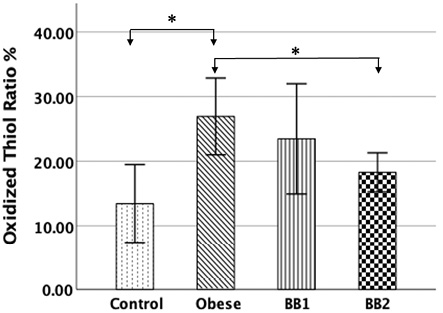
The reduced thiol ratio (RT) was found to be significantly lower in the obese group (%46.0 ± 12.8) compared to the control group (%73.1 ± 13.1) (p = 0.005). Moreover, the RT value in the BB2 group (%63.4 ± 6.5) was significantly higher than that in the obese group (p = 0.005) (Figure 4).
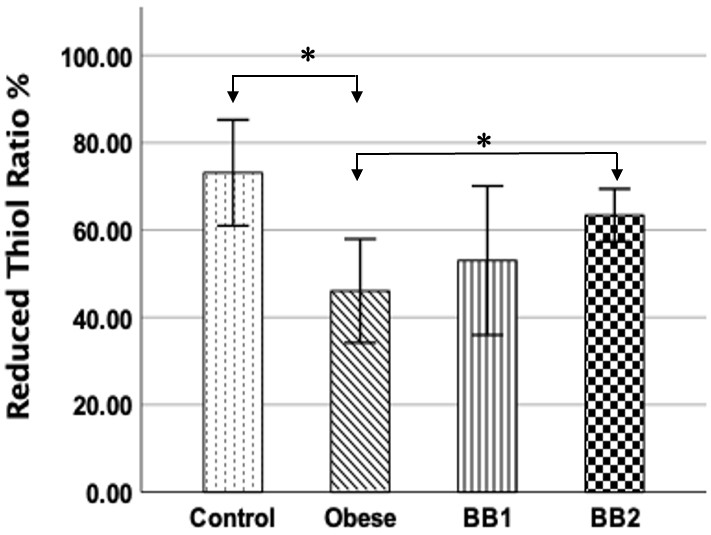
The thiol oxidation-reduction ratio (TOR) was found to be significantly lower in the control group (19.8% [25.7]) compared to the obesity group (61.1% [28.0]) (p=0.005). Although the thiol oxidation-reduction ratio was lower in the BB1 and BB2 groups compared to the obesity group, it was not found to be significant.
Discussion
Obesity is a chronic disease characterized by excess adiposity, which leads to structural and functional consequences, thereby increasing the risk of comorbidities and premature mortality.26 Obesity has financial and social impacts that can affect not only the individual patient but the entire society.27 Therefore, studies aimed at the treatment or prevention of obesity have become a target of great clinical and social importance.
Many methods developed to treat obesity are related to nutritional components. Apitherapy is a type of biotherapy that uses bees and their products (honey, pollen, propolis, BB, royal jelly, bee venom, beewax, apilarnil) as medicinal or preventative of diseases progression. Apitherapy derives its name from the Latin word ”Apis” (bee).28 Honey bees are the “golden insects” that produce honey and other vital bee Products.29 Bee products promote healing through reducing inflammation, enhancing circulation, and inducing a healthy immunological response.28 Bee bread, a hive product formed from a mixture of pollen, honey, and bee salivary secretions, has attracted attention due to its potential health benefits.30 Bee bread has been proven to possess antioxidant, antifungal, antibacterial, and antitumoral activities. Additionally, it has been shown to be effective in alleviating various pathological conditions such as hyperglycemia, hyperlipidemia, inflammation, and OS.16,31 The main components of BB include carbohydrates, proteins, and vitamins, as well as minerals, fatty acids, enzymes, natural antibiotics, antioxidants, and hormones.31,32 Bee bread is considered a beneficial nutritional supplement. This abundance of natural antioxidants in the BB mitigates the ROS generation.31 In recent years, there has been significant interest in the use of BB for the treatment of various Diseases.9-14,22 Considering the known biological activities of BB, we conducted this study to evaluate its effects on obesity within the context of thiol/disulfide homeostasis, hypothesizing that this redox balance may serve as a potential biomarker for the diagnosis and monitoring of obesity. Although various studies have explored the biological properties and effects of BB, the relationship between obesity and thiol/disulfide levels has not been investigated. To the best of our knowledge, this is the first study to investigate.
In this study, based on thiol/disulfide homeostasis measurements conducted after the completion of the experimental protocol in obese mice, native thiol and total thiol levels were found to be significantly lower in the obesity group compared to the control group (p<0.001). This finding suggests that obesity diminishes antioxidant capacity and promotes the oxidation of thiol groups. Such an impact of obesity on oxidative stress may play a critical role in the development of obesity-related comorbidities, such as cardiovascular diseases and diabetes. Consistent with our results, Öklü et al.33 demonstrated that native and total thiol levels decrease as body mass index (BMI) increases. Similarly, another study34 reported that serum total antioxidant capacity was significantly lower in obese individuals compared to their non-obese counterparts. Furthermore, a separate investigation15 found statistically significant reductions in native and total thiol levels in obese subjects compared to controls, indicating that obesity disrupts thiol redox homeostasis. These consistent findings across studies suggest that thiol/disulfide homeostasis could serve as a potential biomarker for assessing oxidative stress in obesity.
The disulfide level appeared to be increased in the obese group compared to the control group, but it was found to be significantly higher compared to the BB2 group (p=0.008). This finding indicates that obesity promotes the conversion of thiols to disulfides, likely driven by heightened oxidative stress (OS). Conversely, the reduced disulfide levels in the BB2 group suggest that the intervention mitigates OS and enhances antioxidant defense mechanisms. Disulfide bonds, formed through the oxidation of thiol groups under conditions of OS, serve as a reliable marker of oxidant activity.24 Thus, the lower disulfide levels in the BB2 group underscore the intervention’s beneficial effect on restoring redox balance. Consistent with these observations, the thiol/disulfide homeostasis system has been widely explored as an indicator of OS in various clinical contexts. For instance, a study in patients with stable coronary artery disease demonstrated that elevated disulfide levels were associated with impaired collateral vessel development, suggesting that thiol/disulfide balance could serve as a prognostic biomarker in cardiovascular conditions.35 Similarly, in patients with acute coronary syndrome, thiol levels and thiol/disulfide ratios were highlighted as potential antioxidant biomarkers for disease evaluations.36 These findings align with our study, where increased OS in obesity shifts the thiol/disulfide equilibrium, reinforcing the potential of these parameters as diagnostic and monitoring tools. Additionally, research on individuals with type 2 diabetes has shown that higher serum thiol (R-SH) levels correlate with improved metabolic control and reduced complications, further supporting the role of thiol/disulfide homeostasis in assessing systemic redox status.37 Moreover, Taşkın et al. emphasized that preserving thiol groups and minimizing disulfide formation during exercise serve as critical biochemical indicators of reduced OS.38 While thiol/disulfide homeostasis has been extensively studied in exercise, diabetes, and cardiovascular disease models, its evaluation in the context of obesity, particularly with BB supplementation, distinguishes our study. This novel application highlights the potential of thiol/disulfide parameters as sensitive biomarkers for assessing the efficacy of antioxidant interventions in obesity-related oxidative stress, warranting further investigation into their clinical applicability.
The oxidized thiol ratio was significantly higher in the obesity group compared to the control group (p=0.005), reflecting an increase in oxidative stress (OS). In contrast, the oxidized thiol ratio was significantly lower in the BB2 group compared to the obesity group (p=0.005), indicating that BB2 supplementation effectively mitigates OS and restores oxidative balance. Similarly, the reduced thiol ratio was significantly lower in the obesity group compared to the control group (p=0.005), underscoring a diminished antioxidant capacity in obesity. However, the reduced thiol ratio was significantly higher in the BB2 group compared to the obesity group (p=0.005), suggesting that BB2 supplementation bolsters the antioxidant defense system and promotes thiol/disulfide homeostasis. These findings align with prior research demonstrating that disruptions in thiol redox balance are associated with obesity-related oxidative stress. 33,34 The ability of BB2 supplementation to reverse these alterations highlights its potential as a therapeutic intervention for mitigating oxidative damage in obesity. Notably, the consistent improvement in both oxidized and reduced thiol ratios in the BB2 group underscores the intervention’s role in enhancing systemic redox status, a finding that distinguishes our study from existing literature, which has primarily focused on thiol homeostasis in other conditions such as diabetes or cardiovascular Disease.35-37 These results suggest that the thiol/disulfide balance could serve as a sensitive biomarker for evaluating the efficacy of antioxidant interventions in obesity, warranting further exploration in clinical settings to validate its translational potential.
The thiol oxidation-reduction ratio (TOR) was significantly lower in the control group compared to the obese group (p=0.005), reflecting heightened oxidative stress (OS) in obesity due to increased thiol oxidation. This finding is consistent with our earlier observations of elevated oxidized thiol ratios (p=0.005), reduced thiol ratios (p=0.005), and increased disulfide levels (p=0.008) in obese subjects, underscoring the disruption of thiol/disulfide homeostasis in obesity. Notably, the TOR was lower in both the BB1 and BB2 intervention groups compared to the obesity group, with a more pronounced decrease in the BB2 group, although these differences did not reach statistical significance. This trend aligns with our prior findings that BB2 supplementation significantly reduces oxidized thiol ratios (p=0.005) and disulfide levels (p=0.008) while increasing reduced thiol ratios (p=0.005), suggesting that BB2 supplementation mitigates OS and enhances antioxidant defense in obesity. These results are consistent with a recent study in obese children, which reported significantly lower levels of native thiol, total thiol, and the native/total thiol ratio, along with higher levels of disulfide, disulfide/native thiol ratio, and disulfide/total thiol ratio in metabolically unhealthy obese (MUO) children compared to controls. These findings indicate a pronounced oxidative imbalance in metabolically compromised obesity. The same study proposed that thiol/disulfide homeostasis may serve as a reliable biomarker of oxidant-antioxidant status in MUO children, supporting our hypothesis that these parameters are sensitive indicators of redox status in obesity.15 Our findings extend this framework by evaluating BB1 and BB2 supplementation in an obesity model, a novel approach compared to prior studies focused on diabetes, cardiovascular disease, or exercise.33,35-38 The lack of statistical significance in TOR differences for BB1 and BB2 groups may reflect factors such as sample size, intervention duration, or variability in response to supplementation. Nevertheless, the consistent trends across thiol-related parameters in our study, particularly with BB2, highlight its potential as a therapeutic intervention for restoring redox homeostasis. These findings suggest that thiol/disulfide homeostasis, including TOR, could serve as a valuable biomarker for assessing the efficacy of antioxidant interventions in obesity, particularly in metabolically unhealthy individuals.
Thiol oxidation-reduction ratio (TOR) was found to be significantly lower in the control group compared to the obesity group (p=0.005), which reveals the increased OS level with obesity. Although a more significant decrease in TOR value was observed in the BB2 group, this difference was not found to be statistically significant, although TOR values were lower in both the BB1 and BB2 groups compared to the obesity group. This result suggests that the BB2 group may positively affect the oxidative balance. Although there is no study examining BB specifically for obesity-related thiol/disulfide levels, as in this study, there are several studies in the literature showing that BB reduces OS by exhibiting antioxidant properties.13,39,40
Conclusion
In conclusion, the obtained data show that obesity increases OS by disrupting thiol/disulfide homeostasis, and BB treatment has the potential to partially restore this balance. Both BB1 and especially BB2 application exhibited positive effects in terms of reducing obesity-related OS. The decrease in disulfide level and the increase in reduced thiol ratio in the BB2 group revealed that this group presented a more advantageous oxidative profile compared to the obesity group. In this study, it was observed that BB2 applied at a dose of 500 mg/kg was more effective, but it was concluded that additional or long-term interventions may be needed to fully restore thiol/disulfide homeostasis.
In this study, it was shown that bee bread (perga) application corrected obesity-related thiol-disulfide imbalances and significantly reduced disulfide levels; this effect is thought to be due to the redox balance modulating capacity of phenolic compounds, flavonoids and other bioactive antioxidants naturally found in perga. These results provide new and original contributions to the literature regarding the use of functional natural products in the management of obesity-related OS disorders.
Acknowledgments
This study forms part of PhD thesis. We gratefully acknowledge the financial support provided by the Scientific and Technological Research Council of Turkey (TÜBİTAK). We are also grateful to the staff of the Harran University Animal Experiment Application and Research Center Laboratories for their technical assistance in animal care and sample collection.
Ethical approval
This study has been approved by the Harran University Local Ethics Committee for Animal Experiments (approval date 14.02.2024, number 2024/001/14). Written informed consent was obtained from the participants.
Source of funding
This work was supported by the Scientific and Technological Research Council of Türkiye (TÜBİTAK) within the scope of the 1002-A program (Project No: 224S453).
Conflict of interest
The authors declare that there is no conflict of interest.
References
- Roberto CA, Swinburn B, Hawkes C, et al. Patchy progress on obesity prevention: emerging examples, entrenched barriers, and new thinking. Lancet. 2015;385:2400-2409. https://doi.org/10.1016/S0140-6736(14)61744-X
- Perdomo CM, Cohen RV, Sumithran P, Clément K, Frühbeck G. Contemporary medical, device, and surgical therapies for obesity in adults. Lancet. 2023;401:1116-1130. https://doi.org/10.1016/S0140-6736(22)02403-5
- World Health Organization (WHO). Obesity and overweight. 2024; Available at: https://www.who.int/news-room/fact-sheets/detail/obesity-and-overweight(Accessed on Apr 20, 2025).
- Rubino F, Cummings DE, Eckel RH, et al. Definition and diagnostic criteria of clinical obesity. Lancet Diabetes Endocrinol. 2025;13:221-262. https://doi.org/10.1016/S2213-8587(24)00316-4
- Manna P, Jain SK. Obesity, oxidative stress, adipose tissue dysfunction, and the associated health risks: causes and therapeutic strategies. Metab Syndr Relat Disord. 2015;13:423-444. https://doi.org/10.1089/met.2015.0095
- Yu J, Qiu J, Zhang Z, et al. Redox biology in adipose tissue physiology and obesity. Adv Biol (Weinh). 2023;7:e2200234. https://doi.org/10.1002/adbi.202200234
- Fernández-Sánchez A, Madrigal-Santillán E, Bautista M, et al. Inflammation, oxidative stress, and obesity. Int J Mol Sci. 2011;12:3117-3132. https://doi.org/10.3390/ijms12053117
- Erel Ö, Erdoğan S. Thiol-disulfide homeostasis: an integrated approach with biochemical and clinical aspects. Turk J Med Sci. 2020;50:1728-1738. https://doi.org/10.3906/sag-2003-64
- Othman Z, Ghazali WS, Noordin L, Yusof NAMohd, Mohamed M. Hypolipidaemic and cardioprotective effects of bee bread harvested from stingless bee (Heterotrigona Itama) in High-Fat Diet-Induced Obese Animal Model. IIUM Medical Journal Malaysia. 2025;24. https://doi.org/10.31436/imjm.v24i01.2508
- Martiniakova M, Blahova J, Kovacova V, et al. Bee bread can alleviate lipid abnormalities and impaired bone morphology in obese zucker diabetic rats. Molecules. 2021;26:2616. https://doi.org/10.3390/molecules26092616
- Suleiman JB, Abu Bakar AB, Noor MM, et al. Bee bread mitigates downregulation of steroidogenic genes, decreased spermatogenesis, and epididymal oxidative stress in male rats fed with high-fat diet. Am J Physiol Endocrinol Metab. 2021;321:E351-E366. https://doi.org/10.1152/ajpendo.00093.2021
- Othman ZA, Zakaria Z, Suleiman JB, et al. Bee bread ameliorates vascular inflammation and impaired vasorelaxation in obesity-induced vascular damage rat model: the role of eNOS/NO/cGMP-Signaling pathway. Int J Mol Sci. 2021;22:4225. https://doi.org/10.3390/ijms22084225
- Suleiman JB, Mohamed M, Abu Bakar AB, Zakaria Z, Othman ZA, Nna VU. Therapeutic effects of bee bread on obesity-induced testicular-derived oxidative stress, inflammation, and apoptosis in high-fat diet obese rat model. Antioxidants (Basel). 2022;11:255. https://doi.org/10.3390/antiox11020255
- Doğanyiğit Z, Yakan B, Soylu M, Kaymak E, Silici S. The effects of feeding obese rats with bee bread on leptin and ghrelin expression. Turkish Journal of Zoology. 2020;44:114-125. https://doi.org/10.3906/zoo-1911-16
- Mengen E, Uçaktürk SA, Kocaay P, Kaymaz Ö, Neşelioğlu S, Erel Ö. The Significance of thiol/disulfide homeostasis and ischemia-modified albumin levels in assessing oxidative stress in obese children and adolescents. J Clin Res Pediatr Endocrinol. 2020;12:45-54. https://doi.org/10.4274/jcrpe.galenos.2019.2019.0039
- Bakour M, Laaroussi H, Ousaaid D, et al. Bee bread as a promising source of bioactive molecules and functional properties: an Up-To-Date review. Antibiotics (Basel). 2022;11:203. https://doi.org/10.3390/antibiotics11020203
- Baky MH, Abouelela MB, Wang K, Farag MA. Bee pollen and bread as a super-food: a comparative review of their metabolome composition and quality assessment in the context of best recovery conditions. Molecules. 2023;28:715. https://doi.org/10.3390/molecules28020715
- Habryka C, Socha R, Juszczak L. The influence of bee bread on antioxidant properties, sensory and quality characteristics of multifloral honey. Applied Sciences. 2023;13:7913. https://doi.org/10.3390/app13137913
- Othman ZA, Noordin L, Ghazali WS, Omar N, Mohamed M. Nutritional, phytochemical and antioxidant analysis of bee bread from different regions of Malaysia. Indian J Pharm Sci. 2019;81:955-960. https://doi.org/10.36468/pharmaceutical-sciences.590
- Sun S, Liu Z, Lin M, Gao N, Wang X. Polyphenols in health and food processing: antibacterial, anti-inflammatory, and antioxidant insights. Front Nutr. 2024;11:1456730. https://doi.org/10.3389/fnut.2024.1456730
- Rudrapal M, Khairnar SJ, Khan J, et al. Dietary polyphenols and their role in oxidative stress-induced human diseases: insights into protective effects, antioxidant potentials and mechanism(s) of action. Front Pharmacol. 2022;13:806470. https://doi.org/10.3389/fphar.2022.806470
- Doğanyiğit Z, Yakan B, Kaymak E. The Effects of feeding obese rats by bee bread on IL-6 expression in rat Stomach. Proc West Mark Ed Assoc Conf[/ITALIC. 2018;2:1570. https://doi.org/10.3390/proceedings2251570
- An T, Liu JX, Yang XY, Lv BH, Wu YX, Jiang GJ. Supplementation of quinoa regulates glycolipid metabolism and endoplasmic reticulum stress in the high-fat diet-induced female obese mice. Nutr Metab (Lond). 2021;18:95. https://doi.org/10.1186/s12986-021-00622-8
- Erel O, Neselioglu S. A novel and automated assay for thiol/disulphide homeostasis. Clin Biochem. 2014;47:326-332. https://doi.org/10.1016/j.clinbiochem.2014.09.026
- Ellman G, Lysko H. A precise method for the determination of whole blood and plasma sulfhydryl groups. Anal Biochem. 1979;93:98-102.
- Elmaleh-Sachs A, Schwartz JL, Bramante CT, Nicklas JM, Gudzune KA, Jay M. Obesity management in adults: a review. JAMA. 2023;330:2000-2015. https://doi.org/10.1001/jama.2023.19897
- Harris L, Hamilton S, Azevedo LB, et al. Intermittent fasting interventions for treatment of overweight and obesity in adults: a systematic review and meta-analysis. JBI Database System Rev Implement Rep. 2018;16:507-547. https://doi.org/10.11124/JBISRIR-2016-003248
- El-Didamony SE, Gouda HI, Zidan MM, Amer RI. Bee products: an overview of sources, biological activities and advanced approaches used in apitherapy application. Biotechnol Rep (Amst). 2024;44:e00862. https://doi.org/10.1016/j.btre.2024.e00862
- Faqihi RA, Taha EA. Apitherapy as an alternative medicine: article review. African Journal of Biological Sciences. 2022;18:43-57. https://doi.org/10.21608/ajbs.2022.251260
- Nahya N. The Bee bread as super food: an up-to-date review in terms of chronic diseases. Advances in Chronic Diseases. 2024;1:37-43. doi:10.5281/zenodo.10903147
- Khalifa SA, Elashal M, Kieliszek M, et al. Recent insights into chemical and pharmacological studies of bee bread. Trends Food Sci Technol. 2020;97:300-316. https://doi.org/10.1016/j.tifs.2019.08.021
- Ćirić J, Haneklaus N, Rajić S, Baltić T, Lazić IB, Đorđević V. Chemical composition of bee bread (perga), a functional food: a review. Journal of Trace Elements and Minerals. 2022;2:100038. https://doi.org/10.1016/j.jtemin.2022.100038
- Öklü K, Çifçi A, Gün Güneş A, Durmaz Ceylan Ş, Erel Ö. Evaluation of the effect of obesity on oxidative stress with thiol/disulphide balance. Intercontinental Journal of Internal Medicine. 2023;1:8-14. https://doi.org/10.51271/ICJIM-0002
- Anaya-Morua W, Villafan-Bernal JR, Ramírez-Moreno E, et al. Total antioxidant capacity in obese and non-obese subjects and its association with anthropo-metabolic markers: systematic review and meta-analysis. Antioxidants (Basel). 2023;12:1512. https://doi.org/10.3390/antiox12081512
- Doğan Y, Yilmaz Y, Keleşoğlu S, et al. Are thiols useful biomarkers for coronary collateral circulation in patients with stable coronary artery disease? J Clin Med. 2023;12:6361. https://doi.org/10.3390/jcm12196361
- Ergün G, Keleşoğlu Ş, Tekin K, et al. A new biomarker in the distinction between stable coronary artery disease and acute coronary syndrome: thiols. Journal of Contemporary Medicine. 2022;12:526-531. https://doi.org/10.16899/jcm.981853
- Schillern EE, Pasch A, Feelisch M, et al. Serum free thiols in type 2 diabetes mellitus: a prospective study. J Clin Transl Endocrinol. 2019;16:100182. https://doi.org/10.1016/j.jcte.2019.100182
- Taşkın S, Çelik H, Taşkın A. The effect of anthocyanin administration on redox balance in acute exercise: an experimental study. Cukurova Medical Journal. 2024;49:471-478. https://doi.org/10.17826/cumj.1440184
- Bakour M, Al-Waili NS, El Menyiy N, et al. Antioxidant activity and protective effect of bee bread (honey and pollen) in aluminum-induced anemia, elevation of inflammatory makers and hepato-renal toxicity. J Food Sci Technol. 2017;54:4205-4212. https://doi.org/10.1007/s13197-017-2889-9
- Ilie CI, Spoiala A, Geana EI, et al. Bee bread: a promising source of bioactive compounds with antioxidant properties-first report on some antimicrobial features. Antioxidants (Basel). 2024;13:353. https://doi.org/10.3390/antiox13030353
Copyright and license
Copyright © 2025 The author(s). This is an open-access article under the terms of the Creative Commons Attribution License (CC BY) which permits unrestricted use, distribution, and reproduction in any medium or format, provided the original work is properly cited.






